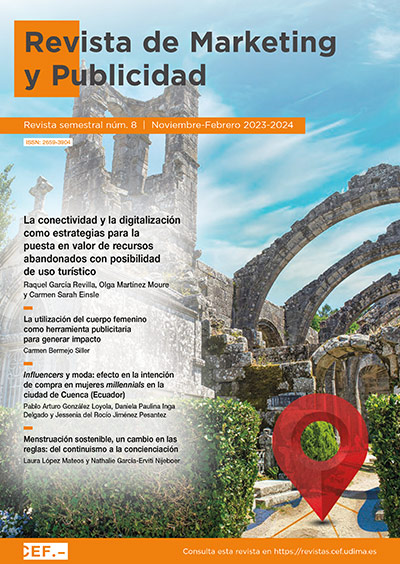Influencers y moda: efecto en la intención de compra en mujeres millennials en la ciudad de Cuenca (Ecuador)
DOI:
https://doi.org/10.51302/marketing.2023.19305Palabras clave:
influencer, intención de compra, modelo de credibilidad de la fuente, millennials, ropa informal, moda, marketingResumen
En la siguiente investigación se aplicará la teoría de la credibilidad de la fuente para determinar el efecto de las características del influencer de Instagram sobre la intención de compra para la generación millennial en la industria de la moda dentro de la categoría ropa informal.
El desarrollo de la investigación se obtuvo mediante una encuesta estructurada a 346 mujeres millennials de Cuenca con una edad comprendida entre 25 a 39 años dentro de la zona urbana, aplicando la técnica de muestreo aleatorio estratificado con afijación proporcional.
Sobre los datos recopilados se realiza un análisis factorial confirmatorio (AFC) para seleccionar y ordenar las variables significativas, utilizando como estimador el de máxima verosimilitud. Finalmente, se aplica el modelado de ecuaciones estructurales (SEM) y así comprobar las hipótesis propuestas para cumplir con los objetivos de la investigación.
Los resultados indican que solo tres características de los influencers tienen relación significativa con la intención de compra, estas son: similitud, experiencia y familiaridad, siendo esta última la que tiene relación directa con la variable dependiente, además que su origen se da por intermedio de los dos constructos mencionados anteriormente. Por otro lado, la confiabilidad no fue significativa, por lo que se descartó del modelo.
Descargas
Citas
Alba, J. W. y Hutchinson, J. W. (1987). Dimensions of consumer expertise. Journal of Consumer Research, 13(4), 411-454. https://doi.org/10.1086/209080
Antevenio. (2022). Millennials y generación Z: descubre cómo actúan en redes sociales estos usuarios. https://www.antevenio.com/blog/2022/05/millennials-y-generacion-z-en-redes-sociales/
Belanche, D., Casaló, L. V., Flavián, M. e Ibáñez Sánchez, S. (2021). Building influencers’ credibility on Instagram: Effects on followers’ attitudes and behavioral responses toward the influencer. Journal of Retailing and Consumer Services, 61. https://doi.org/10.1016/j.jretconser.2021.102585
Bur, A. (2013). Moda, estilo y ciclo de vida de los productos de la industria textil. Cuadernos del Centro de Estudios de Diseño y Comunicación, 45, 143-154.
Casaló, L., Flavián, C. e Ibáñez Sánchez, S. (2017). Antecedents of consumer intention to follow and recommend an Instagram account. Online Information Review, 41(7), 1046-1063. https://doi.org/10.1108/OIR-09-2016-0253
Cervetti, M. (2014). Conflictos por la convivencia de Baby Boomers, Generación X y Generación Y en los equipos de trabajo [tesis de grado].
Chetioui, Y., Benlafqih, H. y Lebdaoui, H. (2020). How fashion influencers contribute to consumers’ purchase intention. Journal of Fashion Marketing and Management: An International Journal, 24(3), 361-380. https://doi.org/10.1108/JFMM-08-2019-0157
Choi, S. M. y Rifon, N. J. (2012). It is a match: The impact of congruence between celebrity image and consumer ideal self on endorsement effectiveness. Psychology & Marketing, 29(9), 639-650. https://doi.org/10.1002/mar.20550
Chun Cui Shan Lim, Wai Meng Tan, Ree Wen Teh y Ee Wen. (2018). Impact of social media influencer on Instagram user purchase intention: the fashion industry. http://malrep.uum.edu.my/rep/Record/my-utar-eprints.3105/Details
Collado, J. (2016). Modelos de ecuaciones estructurales (SEM) para la investigación en Contabilidad y Auditoría. IA Reunión Internacional de Investigación en Contabilidad y Auditoría (RIICA). Universidad de Cantabria.
Cross, J. y Dissanayake, K. (2018). Systematic mechanism for identifying the relative impact of supply chain performance areas on the overall supply chain performance using SCOR model and SEM. Science Direct, 102-115.
Díaz Bravo, L., Torruco-García, U., Martínez Hernández, M. y Varela Ruiz, M. (2013). La entrevista, recurso flexible y dinámico. Investigación en Educación Médica, 2(7), 162-167.
Djafarova, E. y Rushworth, C. (2017). Exploring the credibility of online celebrities’ Instagram profiles in influencing the purchase decisions of young female users. Computers in Human Behavior, 68, 1-7. https://doi.org/10.1016/j.chb.2016.11.009
Droesch, B. (2019). What retailers need to know about influencer marketing? Insider Intelligence. https://www.insiderintelligence.com/content/what-retailers-need-to-know-about-influencer-marketing
Evans, N. J., Phua, J., Lim, J. y Jun, H. (2017). Disclosing Instagram influencer advertising: The effects of disclosure language on advertising recognition, attitudes, and behavioral intent. Journal of Interactive Advertising, 17(2), 138-149. https://doi.org/10.1080/15252019.2017.1366885
Ferrer, L. (2018). Comportamiento del consumidor 2.0: nuevas realidades en entornos digitales. Marketing Visionario, 7(1). http://ojs.urbe.edu/index.php/market/article/view/2727
Freberg, K., Graham, K., McGaughey, K. y Freberg, L. (2011). Who are the social media influencers? A study of public perceptions of personality. Public Relations Review, 37(1). https://doi.org/10.1016/j.pubrev.2010.11.001
Gañán, V. (2018). La importancia de la publicidad en las redes sociales. Servilia. https://blog.servilia.com/la-importancia-de-la-publicidad-en-las-redes-sociales/
Gil Costa, A., Sierra, L. y Madrid, M. (2018). La generación millennial: Nuevas tendencias de consumo. Universidad Pontificia Comillas.
Goldsmith, R., Lafferty, B. y Newell, S. (2000). The influence of corporate credibility on consumer attitudes and purchase intent. Corporate Reputation Review, 3(4), 304-318. https://doi.org/10.1057/palgrave.crr.1540122
Gómez Nieto, B. (2018). El influencer: herramienta clave en el contexto digital de la publicidad engañosa. Methaodos. Revista de Ciencias Sociales, 6(1), 149-156. https://dialnet.unirioja.es/servlet/articulo?codigo=6529430
Gräve, J. F. (2017). Exploring the perception of influencers vs. traditional celebrities. 8th International Conference on Social Media & Society, 1-5. https://doi.org/10.1145/3097286.3097322
Gutiérrez, P., Márquez, P., Diego, G. y Gonzales-Miranda. (2017). Caracterización del comportamiento de los millennials Una revisión de literatura 1. Universidad EAFIT.
Hovland, C. I. y Weiss, W. (1951). The influence of source credibility on communication effectiveness. Public Opinion Quarterly, 15(4), 635-650. https://doi.org/10.1086/266350
INEC (Instituto Nacional de Estadística y Censos). (2010). ¿Cómo crecerá la población en Ecuador? INEC. https://www.ecuadorencifras.gob.ec/documentos/web-inec/Poblacion_y_Demografia/Proyecciones_Poblacionales/presentacion.pdf
INEC. (2018). Hablando de millennials. https://www.ecuadorencifras.gob.ec/documentos/web-inec/Poblacion_y_Demografia/Proyecciones_Poblacionales/presentacion.pdf
Infomarketing. (2020). Instagram, la red social preferida de los millennials para tomar una decisión de compra. https://infomarketing.pe/marketing/noticias/instagram-la-red-social-preferida-de-los-millennials-para-tomar-una-decision-de-compra/
Jiménez Castillo, D. y Sánchez Fernández, R. (2019). The role of digital influencers inbrand recommendation: Examining their impact on engagement, expected value and purchase intention. International Journal of Information Management, 49, 366-376. https://doi.org/10.1016/j.ijinfomgt.2019.07.009
Jin, S. V. y Ryu, E. (2019). Instagram fashionistas, luxury visual image strategies and vanity. Journal of Product & Brand Management, 29(3), 355-368. https://doi.org/10.1108/JPBM-08-2018-1987
Kapitan, S. y Silvera, D. (2016). From digital media influencers to celebrity endorsers: attributions drive endorser effectiveness. Marketing Letters, 27(3), 553-567. https://doi.org/10.1007/s11002-015-9363-0
Kemeç, U. y Yüksel, H. F. (2021). The relationships among influencer credibility, brand trust, and purchase intention: the case of Instagram. Tüketici ve Tüketim Araştırmaları Dergisi = Journal of Consumer and Consumption Research, 13(1), 159-193. https://www.researchgate.net/publication/354985565_The_Relationships_among_Influencer_Credibility_Brand_Trust_and_Purchase_Intention_The_Case_of_Instagram
Kenny, D., Kaniskan, B. y McCoach, B. (2014). The performance of RMSEA in models with small degrees of freedom. Sage Journals.
Kim, D., Seely, N. y Jung, J. H. (2017). Do you prefer, Pinterest or Instagram? The role of image-sharing SNSs and self-monitoring in enhancing ad effectiveness. Computers in Human Behavior, 70, 535-543. https://doi.org/10.1016/j.chb.2017.01.022
Kim, J., Kim, N. y Kim, M. S. (2021). The relationship among characteristics of fashion influencers, relationship immersion, and purchase intention. The Journal of Industrial Distribution y Business, 12(4), 35-51. https://doi.org/10.13106/jidb.2021.vol12.no4.35
Kolo, C. y Haumer, F. (2018). Social media celebrities as influencers in brand communication: An empirical study on influencer content, its advertising relevance and audience expectations. Journal of Digital and Social Media Marketing, 6(3), 273-282.
Launch Metrics. (2018). Estatus del marketing de influencers en 2018: 3 datos clave para recordar. https://www.launchmetrics.com/es/recursos/blog/marketing-de-influencers-informe-2018
Lim, X., Mohd, A., Cheah, J. H. y Wong, M. (2017). The impact of social media influencers on purchase intention and the mediation effect of customer attitude. Asian Journal of Business Research, 7(2), 19-36. https://doi.org/10.14707/ajbr.170035
Lou, C. y Yuan, S. (2019). Influencer marketing: how message value and credibility affect consumer trust of branded content on social media. Journal of Interactive Advertising, 19(1), 58-73. https://doi.org/10.1080/15252019.2018.1533501
Luque, S. y Pérez, C. (2017). El marketing de influencia en moda. Estudio del nuevo modelo de consumo en Instagram de los millennials universitarios. AdComunica, 15. https://doi.org/10.6035/2174-0992.2018.15.13
Martensen, A., Brockenhuus-Schack, S. y Zahid, A. (2018). How citizen influencers persuade their followers. Journal of Fashion Marketing and Management, 22(3), 335-353. https://doi.org/10.1108/JFMM-09-2017-0095
Miranda, M. (2021). Cultura millennial del lenguaje globalizado. Top Comunicación & RR.PP. https://www.topcomunicacion.com/cultura-millennial-del-lenguaje-globalizado/
Na, Y. y Kim, J. (2019). Sensibility and response keywords of users according to posting types of fashion Instagram. International Journal of Clothing Science and Technology, 32(1), 23-36. https://doi.org/10.1108/IJCST-03-2018-0032
Nejad, M., Sherrell, D. y Babakus, E. (2014). Influentials and influence mechanisms in new product diffusion: an integrative review. Journal of Marketing Theory and Practice, 22(2), 185-208. https://doi.org/10.2753/MTP1069-6679220212
Núñez, C. (2013). Publicidad: Simbología de masas. Alvi Books.
Ohanian, R. (1990). Construction and validation of a scale to measure celebrity endorsers’ perceived expertise, trustworthiness, and attractiveness. Journal of Advertising, 19(3), 39-52. https://doi.org/10.1080/00913367.1990.10673191
Ohanian, R. (1991). The impact of celebrity spokespersons’ perceived image on consumers’ intention to purchase. Journal of Advertising Research, 31(1), 46-54.
Pefaur, N. (2017). El viaje de un comentario: un análisis desde la conducta del consumidor. Universidad de Chile. https://repositorio.uchile.cl/handle/2250/145847
Pornpitakpan, C. (2004). The effect of celebrity endorsers’ perceived credibility on product purchase intention. Journal of International Consumer Marketing, 16(2), 55-74. https://doi.org/10.1300/J046v16n02_04
Qaiser, R., Khalid, M., Usman, A., Raza, I. y Afzal, A. (2015). Effect of intrinsic rewards on task performance of employees: mediating role of motivation. International Journal of Organizational Leadership, 4, 33-46.
Rahman, M., Hossain, M. A., Hoque, M., Rushan, M. R. y Rahman, M. (2021). Millennials’ purchasing behavior toward fashion clothing brands: influence of brand awareness and brand schematicity. Journal of Fashion Marketing and Management, 25(1), 153-183. https://doi.org/10.1108/JFMM-07-2019-0137
Ramos, C. (2020). La credibilidad de los influencers en las jóvenes de 20 a 25 años de Lima Metropolitana. USMP. https://repositorio.usmp.edu.pe/bitstream/handle/20.500.12727/7748/RAMOS_IC.pdf?sequence=1&isAllowed=y
Rebelo, M. (2017). How influencer’s credibility on Instagram is perceived by consumers and its impact on purchase intention. Universidad Católica Portuguesa.
Reinikainen, H., Munnukka, J., Maity, D. y Luoma-aho, V. (2020). ‘You really are a great big sister’ – parasocial relationships, credibility, and the moderating role of audience comments in influencer marketing. Journal of Marketing Management, 36(3-4), 279-298. https://doi.org/10.1080/0267257X.2019.1708781
Sanmiguel, P. y Sádaba, T. (2019). Consumo de Información de moda entre los/as millenials. Revista Prisma Social, 24, 186-208.
Santamaría, E., Rufino J. y Péon, M. (2017). Vista de redes sociales y fenómeno influencer. Reflexiones desde una perspectiva psicológica. Revista Comillas, 75(147).
Schiffman, L., Lazar Kanuk, L. y Wisenblit, J. (2010). Comportamiento del consumidor. Prentice Hall.
Schouten, A., Janssen, L. y Verspaget, M. (2020). Celebrity vs. Influencer endorsements in advertising: The role of identification, credibility, and Product-Endorser fit. International Journal of Advertising, 39(2), 258-281. https://doi.org/10.1080/02650487.2019.1634898
Sheldon, P. y Bryant, K. (2016). Instagram: Motives for its use and relationship to narcissism and contextual age. Computers in Human Behavior, 58, 89-97. https://doi.org/10.1016/j.chb.2015.12.059
Shin, E. y Lee, J. (2021). What makes consumers purchase apparel products through social shopping services that social media fashion influencers have worn? Journal of Business Research, 132, 416-428. https://doi.org/10.1016/j.jbusres.2021.04.022
Singh, R. y Banerjee, N. (2018). Exploring the influence of celebrity credibility on brand attitude, advertisement attitude and purchase intention. Global Business Review, 19(6), 1.622-1.639. https://doi.org/10.1177/0972150918794974
Sokolova, K. y Kefi, H. (2020). Instagram and YouTube bloggers promote it, why should I buy? How credibility and parasocial interaction influence purchase intentions. Journal of Retailing and Consumer Services, 53. https://doi.org/10.1016/j.jretconser.2019.01.011
Statista Research Department. (2021). Global influencer market size 2021. https://www.statista.com/statistics/1092819/global-influencer-market-size/
Statista. (2021). Distribución porcentual de los usuarios de Instagram a nivel mundial en 2021, por género y edad. Distribución por género y edad de los usuarios mundiales de Instagram en 2021.
Tarabini, A. (2018). Los/las millenials emergentes en Baleares http://www.gadeso.org/files/2018/07/milenials.pdf
Tsarashafa, T. y Qastharin, A. (2021). How fashion influencer contributes to consumer’s purchase intention of University Student. Advanced International Journal of Business, Entrepreneurship and SMES, 3(9), 209-227. https://doi.org/10.35631/AIJBES.39015
Virkkunen, P. y Norhio, E. (2019). Becoming a social media influencer: Describing the journey of becoming a successful social media influencer. Jönköping University.
We Are Social y Hootsuite. (2021a). Digital 2021 July global statshot report. Global Digital Reports Series.
We Are Social y Hootsuite. (2021b). Digital in Ecuador: All the statistics you need in 2021. https://datareportal.com/reports/digital-2021-ecuador
Wiedmann, K. P. y von Mettenheim, W. (2021). Attractiveness, trustworthiness and expertise - social influencers’ winning formula? Journal of Product & Brand Management, 30(5), 707-725. https://doi.org/10.1108/JPBM-06-2019-2442
Wiedmann, K. P., Hennigs, N. y Langner, S. (2010). Spreading the word of fashion: identifying social influencers in fashion marketing. Journal of Global Fashion Marketing, 1(3), 142-153. https://doi.org/10.1080/20932685.2010.10593066
Zúñiga, J. (2020). Performance over aesthetics: Post- athleisure in Latin America. Euromonitor International.
Descargas
Publicado
Cómo citar
Número
Sección
Licencia
Derechos de autor 2023 Pablo González Loyola, Paulina Inga Delgado, Jessenia Jiménez Pesantez

Esta obra está bajo una licencia internacional Creative Commons Atribución-NoComercial-SinDerivadas 4.0.





















